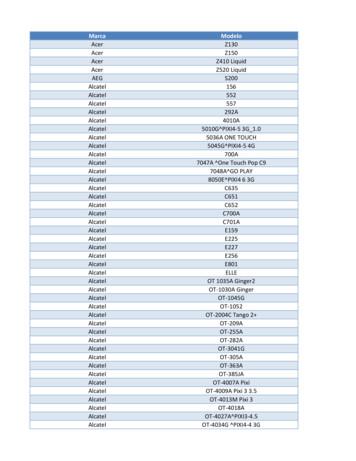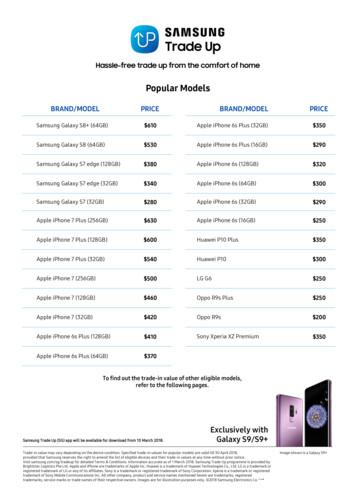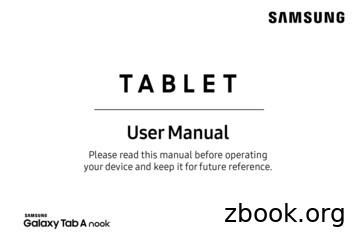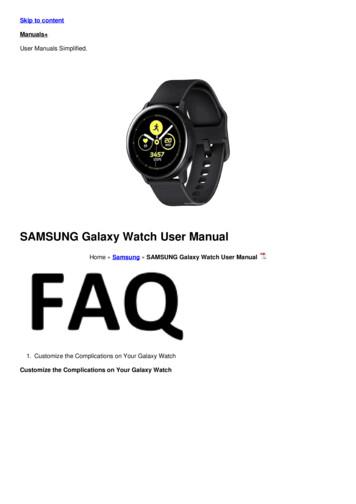APPLE INC. V. SAMSUNG ELECTRONICS CO., LTD
APPLE INC. v. SAMSUNG ELECTRONICS CO., LTD786 F.3d 983 (CAFC 2015)PROST, Chief Judge.Samsung Electronics Co., Ltd., Samsung Electronics America, Inc., Samsung TelecommunicationsAmerica, LLC (collectively, "Samsung") appeal from a final judgment of the U.S. District Court for theNorthern District of California in favor of Apple Inc. ("Apple").A jury found that Samsung infringed Apple's design and utility patents and diluted Apple's tradedresses. For the reasons that follow, we affirm the jury's verdict on the design patent infringements, thevalidity of two utility patent claims, and the damages awarded for the design and utility patent infringements appealed by Samsung. However, we reverse the jury's findings that the asserted trade dresses areprotectable. We therefore vacate the jury's damages awards against the Samsung products that werefound liable for trade dress dilution and remand for further proceedings consistent with this opinion.BACKGROUNDApple sued Samsung in April 2011. On August 24, 2012, the first jury reached a verdict that numerous Samsung smartphones infringed and diluted Apple's patents and trade dresses in various combinations and awarded over 1 billion in damages. The diluted trade dresses are Trademark Registration No. 3,470,983 ("'983 trade dress") [SeeAppendix] and an unregistered trade dress [*990] defined in terms of certain elements in the configuration of the iPhone.Following the first jury trial, the district court upheld the jury's infringement, dilution, and validityfindings over Samsung's post-trial motion. The district court also upheld 639,403,248 in damages, butordered a partial retrial on the remainder of the damages because they had been awarded for a periodwhen Samsung lacked notice of some of the asserted patents. The jury in the partial retrial on damagesawarded Apple 290,456,793, which the district court upheld over Samsung's second post-trial motion.On March 6, 2014, the district court entered a final judgment in favor of Apple, and Samsung filed anotice of appeal. We have jurisdiction under 28 U.S.C. ß 1295(a)(1).DISCUSSIONWe review the denial of Samsung's post-trial motions under the Ninth Circuit's procedural standards. See Revolution Eyewear, Inc. v. Aspex Eyewear, Inc., 563 F.3d 1358, 1370-71 (Fed. Cir. 2009). The NinthCircuit reviews de novo a denial of a motion for judgment as a matter of law. Id. "The test is whetherthe evidence, construed in the light most favorable to the nonmoving party, permits only one reasonable conclusion, and that conclusion is contrary to that of the jury." Id. (citing Theme Promotions, Inc. v.News Am. Mktg. FSI, 546 F.3d 991, 999 (9th Cir. 2008)).The Ninth Circuit reviews a denial of a motion for a new trial for an abuse of discretion. RevolutionEyewear, 563 F.3d at 1372. "In evaluating jury instructions, prejudicial error results when, looking to theinstructions as a whole, the substance of the applicable law was [not] fairly and correctly covered."Gantt v. City of Los Angeles, 717 F.3d 702, 707 (9th Cir. 2013) (quoting Swinton v. Potomac Corp., 270 F.3d794, 802 (9th Cir. 2001)) (alteration in original). The Ninth Circuit orders a new trial based on jury instruction error only if the error was prejudicial. Id. A motion for a new trial based on insufficiency ofevidence may be granted "only if the verdict is against the great weight of the evidence, or it is quite1
clear that the jury has reached a seriously erroneous result." Incalza v. Fendi N. Am., Inc., 479 F.3d 1005,1013 (9th Cir. 2007) (internal quotation marks omitted).Samsung appeals numerous legal and evidentiary bases for the liability findings and damages awardsin the three categories of intellectual property asserted by Apple: trade dresses, design patents, and utility patents. We address each category in turn.I. Trade DressesThe jury found Samsung liable for the likely dilution of Apple's iPhone trade dresses under theLanham Act. When reviewing Lanham Act claims, we look to the law of the regional circuit where thedistrict court sits. ERBE Elektromedizin GmbH v. Canady Tech. LLC, 629 F.3d 1278, 1287 (Fed. Cir. 2010).We therefore apply Ninth Circuit law.The Ninth Circuit has explained that "[t]rade dress is the totality of elements in which a product orservice is packaged or presented." Stephen W. Boney, Inc. v. Boney Servs., Inc., 127 F.3d 821, 828 (9th Cir.1997). The essential purpose of a trade dress is the same as that of a trademarked word: to identify thesource of the product. 1 McCarthy on Trademarks and Unfair Competition ß 8:1 (4th ed.) ("[L]ike aword asserted to be a trademark, the elements making up the alleged trade dress must have been used insuch a manner as to denote product source."). In this respect, "protection for [*991] trade dress existsto promote competition." TrafFix Devices, Inc. v. Mktg. Displays, Inc., 532 U.S. 23, 28, 121 S. Ct. 1255, 149L. Ed. 2d 164 (2001).The protection for source identification, however, must be balanced against "a fundamental right tocompete through imitation of a competitor's product . . . ." Leatherman Tool Grp., Inc. v. Cooper Indus., Inc., 199 F.3d1009, 1011-12 (9th Cir. 1999). This "right can only be temporarily denied by the patent or copyright laws."Id. In contrast, trademark law allows for a perpetual monopoly and its use in the protection of "physicaldetails and design of a product" must be limited to those that are "nonfunctional." Id. at 1011-12; see alsoQualitex Co. v. Jacobson Prods. Co., 514 U.S. 159, 164-65, 115 S. Ct. 1300, 131 L. Ed. 2d 248 (1995) ("If aproduct's functional features could be used as trademarks, however, a monopoly over such featurescould be obtained without regard to whether they qualify as patents and could be extended forever (because trademarks may be renewed in perpetuity)."). Thus, it is necessary for us to determine firstwhether Apple's asserted trade dresses, claiming elements from its iPhone product, are nonfunctionaland therefore protectable."In general terms, a product feature is functional if it is essential to the use or purpose of the articleor if it affects the cost or quality of the article." Inwood Labs., Inc. v. Ives Labs., Inc., 456 U.S. 844, 850n.10, 102 S. Ct. 2182, 72 L. Ed. 2d 606 (1982). "A product feature need only have some utilitarian advantage to be considered functional." Disc Golf Ass'n v. Champion Discs, Inc., 158 F.3d 1002, 1007 (9th Cir.1998). A trade dress, taken as a whole, is functional if it is "in its particular shape because it works better inthis shape." Leatherman, 199 F.3d at 1013."[C]ourts have noted that it is, and should be, more difficult to claim product configuration tradedress than other forms of trade dress." Id. at 1012-13 (discussing cases). Accordingly, the SupremeCourt and the Ninth Circuit have repeatedly found product configuration trade dresses functional andtherefore non-protectable. See, e.g., TrafFix, 532 U.S. at 26-27, 35 (reversing the Sixth Circuit's reversalof the district court's grant of summary judgment that a trade dress on a dual-spring design for temporary road sign stands was functional); Secalt S.A. v. Wuxi Shenxi Const. Mach. Co., 668 F.3d 677, 687 (9thCir. 2012) (affirming summary judgment that a trade dress on a hoist design was functional); Disc Golf,2
158 F.3d at 1006 (affirming summary judgment that a trade dress on a disc entrapment design was functional).Moreover, federal trademark registrations have been found insufficient to save product configuration trade dresses from conclusions of functionality. See, e.g., Talking Rain Beverage Co. v. S. Beach Beverage,349 F.3d 601, 602 (9th Cir. 2003) (affirming summary judgment that registered trade dress covering abottle design with a grip handle was functional); Tie Tech, Inc. v. Kinedyne Corp., 296 F.3d 778, 782-83 (9thCir. 2002) (affirming summary judgment that registered trade dress covering a handheld cutter designwas functional). The Ninth Circuit has even reversed a jury verdict of non-functionality of a productconfiguration trade dress. See Leatherman, 199 F.3d at 1013 (reversing jury verdict that a trade dress onthe overall appearance of a pocket tool was non-functional). Apple conceded during oral argument thatit had not cited a single Ninth Circuit case that found a product configuration trade dress to be nonfunctional. Oral Arg. 49:06-30, available at ngs/141335/all.[*992] The Ninth Circuit's high bar for non-functionality frames our review of the two iPhonetrade dresses on appeal. While the parties argue without distinguishing the two trade dresses, the unregistered trade dress and the registered '983 trade dress claim different details and are afforded differentevidentiary presumptions under the Lanham Act. We analyze the two trade dresses separately below.A. Unregistered Trade DressApple claims elements from its iPhone 3G and 3GS products to define the asserted unregisteredtrade dress:a rectangular product with four evenly rounded corners;a flat, clear surface covering the front of the product;a display screen under the clear surface;substantial black borders above and below the display screen and narrower black borders on either side of the screen; andwhen the device is on, a row of small dots on the display screen, a matrix of colorfulsquare icons with evenly rounded corners within the display screen, and an unchangingbottom dock of colorful square icons with evenly rounded corners set off from the display's other icons.Appellee's Br. 10-11. As this trade dress is not registered on the principal federal trademark register,Apple "has the burden of proving that the claimed trade dress, taken as a whole, is not functional . . . ."See 15 U.S.C. ß 1125(c)(4)(A).Apple argues that the unregistered trade dress is nonfunctional under each of the Disc Golf factorsthat the Ninth Circuit uses to analyze functionality: "(1) whether the design yields a utilitarian advantage, (2) whether alternative designs are available, (3) whether advertising touts the utilitarian advantages of the design, and (4) whether the particular design results from a comparatively simple or inexpensive method of manufacture." See Disc Golf, 158 F.3d at 1006. However, the Supreme Court hasmore recently held that "a feature is also functional . . . when it affects the cost [**12] or quality of thedevice." See TrafFix, 532 U.S. at 33. The Supreme Court's holding was recognized by the Ninth Circuitas "short circuiting some of the Disc Golf factors." Secalt, 668 F.3d at 686-87. Nevertheless, we explore3
Apple's contentions on each of the Disc Golf factors and conclude that there was insufficient evidenceto support a jury finding in favor of nonfunctionality on any factor.1. Utilitarian AdvantageApple argues that "the iPhone's physical design did not 'contribute unusually . . . to the usability' ofthe device." Appellee's Br. 61 (quoting J.A. 41095:11-12) (alteration in original). Apple further contendsthat the unregistered trade dress was "developed . . . not for 'superior performance.'" Id. at 62 n.18. Neither "unusual usability" nor "superior performance," however, is the standard used by the Ninth Circuitto determine whether there is any utilitarian advantage. The Ninth Circuit "has never held, as [plaintiff]suggests, that the product feature must provide superior utilitarian advantages. To the contrary, [theNinth Circuit] has suggested that in order to establish nonfunctionality the party with the burden mustdemonstrate that the product feature serves no purpose other than identification." Disc Golf, 158 F.3d at1007 (internal quotation marks omitted).The requirement that the unregistered trade dress "serves no purpose other than identification" cannot be reasonably inferred from the evidence. Apple emphasizes [*993] a single aspect of its design,beauty, to imply the lack of other advantages. But the evidence showed that the iPhone's design pursued more than just beauty. Specifically, Apple's executive testified that the theme for the design of theiPhone was:to create a new breakthrough design for a phone that was beautiful and simple and easy touse and created a beautiful, smooth surface that had a touchscreen and went right to therim with the bezel around it and looking for a look that we found was beautiful and easy touse and appealing.J.A. 40722-23 (emphases added).Moreover, Samsung cites extensive evidence in the record that showed the usability function ofevery single element in the unregistered trade dress. For example, rounded corners improve "pocketability" and "durability" and rectangular shape maximizes the display that can be accommodated. J.A.40869-70; J.A. 42612-13. A flat clear surface on the front of the phone facilitates touch operation byfingers over a large display. J.A. 42616-17. The bezel protects the glass from impact when the phone isdropped. J.A. 40495. The borders around the display are sized to accommodate other componentswhile minimizing the overall product dimensions. J.A. 40872. The row of dots in the user interface indicates multiple pages of application screens that are available. J.A. 41452-53. The icons allow users todifferentiate the applications available to the users and the bottom dock of unchanging icons allows forquick access to the most commonly used applications. J.A. 42560-61; J.A. 40869-70. Apple rebuts noneof this evidence.Apple conceded during oral argument that its trade dress "improved the quality [of the iPhone] insome respects." Oral Arg. 56:09-17. It is thus clear that the unregistered trade dress has a utilitarian advantage. See Disc Golf, 158 F.3d at 1007.2. Alternative DesignsThe next factor requires that purported alternative designs "offer exactly the same features" as theasserted trade dress in order to show non-functionality. Tie Tech, 296 F.3d at 786 (quoting Leatherman,199 F.3d at 1013-14). A manufacturer "does not have rights under trade dress law to compel its competitors to resort to alternative designs which have a different set of advantages and disadvantages." Id.4
Apple, while asserting that there were "numerous alternative designs," fails to show that any of thesealternatives offered exactly the same features as the asserted trade dress. Appellee's Br. 62. Apple simplycatalogs the mere existence of other design possibilities embodied in rejected iPhone prototypes andother manufacturers' smartphones. The "mere existence" of other designs, however, does not provethat the unregistered trade dress is non-functional. See Talking Rain, 349 F.3d at 604.3. Advertising of Utilitarian Advantages"If a seller advertises the utilitarian advantages of a particular feature, this constitutes strong evidence of functionality." Disc Golf, 158 F.3d at 1009. An "inference" of a product feature's utility in theplaintiff's advertisement is enough to weigh in favor of functionality of a trade dress encompassing thatfeature. Id.Apple argues that its advertising was "[f]ar from touting any utilitarian advantage of the iPhone design . . . ." Appellee's Br. 60. Apple relies on its executive's testimony that an iPhone advertisement,portraying "the distinctive design very [*994] clearly," was based on Apple's "product as hero" approach. Id. (quoting J.A. 40641-42; 40644:22). The "product as hero" approach refers to Apple's stylisticchoice of making "the product the biggest, clearest, most obvious thing in [its] advertisements, often atthe expense of anything else around it, to remove all the other elements of communication so [theviewer] see[s] the product most predominantly in the marketing." J.A. 40641-42.Apple's arguments focusing on its stylistic choice, however, fail to address the substance of its advertisements. The substance of the iPhone advertisement relied upon by Apple gave viewers "the abilityto see a bit about how it might work," for example, "how flicking and scrolling and tapping and all these multitouch ideas simply [sic]." J.A. 40644:23-40645:2. Another advertisement cited by Apple similarlydisplayed the message, "[t]ouching is believing," under a picture showing a user's hand interacting withthe graphical user interface of an iPhone. J.A. 24896. Apple fails to show that, on the substance, thesedemonstrations of the user interface on iPhone's touch screen involved the elements claimed in Apple'sunregistered trade dress and why they were not touting the utilitarian advantage of the unregisteredtrade dress.4. Method of ManufactureThe fourth factor considers whether a functional benefit in the asserted trade dress arises from"economies in manufacture or use," such as being "relatively simple or inexpensive to manufacture."Disc Golf, 158 F.3d at 1009.Apple contends that "[t]he iPhone design did not result from a 'comparatively simple or inexpensive method of manufacture'" because Apple experienced manufacturing challenges. Appellee's Br. 61(quoting Talking Rain, 349 F.3d at 603). Apple's manufacturing challenges, however, resulted from thedurability considerations for the iPhone and not from the design of the unregistered trade dress. According to Apple's witnesses, difficulties resulted from its choices of materials in using "hardened steel";"very high, high grade of steel"; and, "glass that was not breakable enough, scratch resistant enough."Id. (quoting J.A. 40495-96, 41097). These materials were chosen, for example, for the iPhone to survivea drop:If you drop this, you don't have to worry about the ground hitting the glass. You have toworry about the band of steel surrounding the glass hitting the glass. . . . In order to, tomake it work, we had to use very high, high grade of steel because we couldn't have it sortof deflecting into the glass.5
J.A. 40495-96. The durability advantages that resulted from the manufacturing challenges, however, areoutside the scope of what Apple defines as its unregistered trade dress. For the design elements thatcomprise Apple's unregistered trade dress, Apple points to no evidence in the record to show they werenot relatively simple or inexpensive to manufacture. See Disc Golf, 158 F.3d at 1009 ("[Plaintiff], whichhas the burden of proof, offered no evidence that the [asserted] design was not relatively simple or inexpensive to manufacture.").In sum, Apple has failed to show that there was substantial evidence in the record to support a juryfinding in favor of non-functionality for the unregistered trade dress on any of the Disc Golf factors.Apple fails to rebut the evidence that the elements in the unregistered trade dress serve the functionalpurpose of improving usability. Rather, Apple focuses on the "beauty" of its design, even though Applepursued both "beauty" and functionality in the design of the iPhone. We therefore [*995] reverse thedistrict court's denial of Samsung's motion for judgment as a matter of law that the unregistered tradedress is functional and therefore not protectable.B. The Registered '983 Trade DressIn contrast to the unregistered trade dress, the '983 trade dress is a federally registered trademark.The federal trademark registration provides "prima facie evidence" of non-functionality. Tie Tech, 296F.3d at 782-83. This presumption "shift[s] the burden of production to the defendant . . . to provideevidence of functionality." Id. at 783. Once this presumption is overcome, the registration loses its legalsignificance on the issue of functionality. Id. ("In the face of sufficient and undisputed facts demonstrating functionality, . . . the registration loses its evidentiary significance.").The '983 trade dress claims the design details in each of the sixteen icons on the iPhone's homescreen framed by the iPhone's rounded-rectangular shape with silver edges and a black background:The first icon depicts the letters "SMS" in green inside a white speech bubble on a greenbackground;.the seventh icon depicts a map with yellow and orange roads, a pin with a red head,and a redand-blue road sign with the numeral "280" in
when Samsung lacked notice of some of the asserted patents. The jury in the partial retrial on damages awarded Apple 290,456,793, which the district court upheld over Samsung's second post-trial motion. On March 6, 2014, the district court entered a final judgment in favor of Apple, and Samsung filed a notice of appeal.
Samsung SGH-D807 Samsung SGH-D900 Samsung SGH-E215L Samsung SGH-E251L Samsung SGH-E256 Samsung SGH-E316 Samsung SGH-E356 Samsung SGH-E376 Samsung SGH-E496 Samsung SGH-E608 Samsung SGH-E630 Samsung SGH-E720 Samsung SGH-E736. Marca Modelo Samsung SGH-E786 Samsung SGH-E906 Samsung SGH-F250L Samsung SGH
Samsung Galaxy S6 (32GB) 100 Samsung Galaxy S5 60 Samsung Galaxy A9 Pro 250 Samsung Galaxy A8 100 Samsung Galaxy A7 2017 200 Samsung Galaxy A7 2016 130 Samsung Galaxy A7 50 Samsung Galaxy A5 2017 150 Samsung Galaxy A5 2016 100 Samsung Galaxy A5 50 Samsung Galaxy A3 2016 80 Samsung Galaxy
Samsung Electronics America (SEA), Inc. Address: 85 Challenger Road Ridgefield Park, New Jersey 07660 Phone: 1-800-SAMSUNG (726-7864) Internet Address: samsung.com 2016 Samsung Electronics America, Inc. Samsung, Samsung Galaxy, Multi Window, S Pen, S Health, S Voice, Samsung Pay, and Samsung Milk Music are all
4. Samsung Galaxy Watch Active User Manual Samsung Galaxy Watch Active User Manual - Download [optimized]Samsung Galaxy. 5. Samsung Galaxy Watch Active User Manual Samsung Galaxy Watch Active User Manual - Download [optimized]Samsung Galaxy. 6. SAMSUNG Galaxy Watch Active User Manual Samsung Galaxy Watch Active Quick Start Guide 1 .
CANADA 1-800-SAMSUNG (726-7864) www.samsung.com Samsung Electronics Canada Inc., Customer Service 55 Standish Court Mississauga, Ontario L5R 4B2 Canada U.S.A 1-800-SAMSUNG (726-7864) www.samsung.com Samsung Electronics America, Inc. 85 Challenger Road Ridgefi eld Park, NJ 07660 Plasma TV user manual SUPPORT
- Samsung Electronics Co., Ltd. ("SEC" or "the Company") was established as Samsung Electronics Industry Co., Ltd. on January 13, 1969, and held an initial public offering on June 11, 1975. - SEC changed its name from Samsung Electronics Industry Co., Ltd. to Samsung Electronics Co., Ltd. following a
Samsung Electronics Co., Ltd. 129 Samsung-ro, Yeongtong-gu, Suwon-si, Gyeonggi-do 443-742, Korea www.samsung.com 2015-08 About Samsung Electronics Co., Ltd. Samsung Electronics Co., Ltd. inspires the world and shapes the future with transformative ideas and technologies, redefining the worlds of TVs, smartphones, wearable devices,
Add a Samsung account. Sign in to your Samsung account to access exclusive Samsung content and make full use of Samsung apps. 1. From Settings, tap Accounts and backup Accounts. 2. Tap Add account Samsung account. TIP To quickly access your Samsung account, from. Settings tap Samsung account. Add an email account























